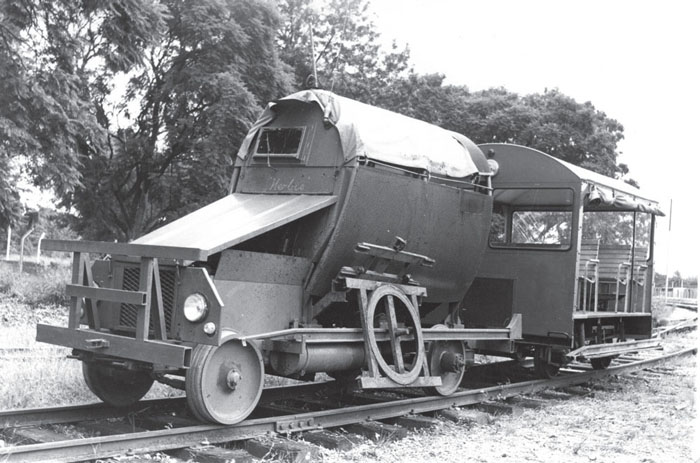
In our opinion, the defence of the railway network during the 1972–9 bush war in Rhodesia2 by the security forces against the guerrillas of ZIPRA and ZANLA, who were armed respectively by the Russians and the Chinese,3 is the rail conflict which produced the most innovations in armoured rolling stock.
The first attacks on commercial trains began in January 1975 on the line between Thomson Junction and Victoria Falls. At first security patrols were carried out using unarmoured Wickham inspection trolleys (Types 3, 4, 5 and 6), nicknamed ‘Green Beans’. Very quickly it was realised that armoured rail vehicles would be required. The concept initially chosen would remain the standard for all subsequent vehicles, namely an armoured ‘capsule’ with a V-shaped cross-section, mounted on an existing chassis. The first type of armoured capsule, called the ‘Rhino’, was adapted to fit on the Land Rover LWB5 chassis. The Rhino immediately attracted the interest of the railway operators, and late in 1976 three armoured capsules were delivered to the central railway maintenance workshops in Bulawayo for evaluation. During the war the MAP6 vehicles were continuously developed, increased protection and an improved drive train being added to the Rhino and later designs, culminating in the ultimate armoured trolley, the Cougar.

The original Rhino model, with the turntable carried at the side together with one of the rails which allowed the trolley to drive onto the turntable, and the rail wheels fixed directly onto the axles without any intermediate drive system, which would cause many problems because of the vibration. Bringing up the rear is a Wickham Type 18 Mk VI inspection trolley.
(Photo: National Railways Museum, Bulawayo)
The first Rhino model was mounted on a standard Land Rover chassis, modified for use on the rails. The initial problem to be surmounted was the fitting of special rail wheels, because the Land Rover’s wheelbase was wider than the local rail gauge of 1067mm (3ft 6in).
A wheel had to be designed with its rolling surface inboard of the outer end of the vehicle’s axle. In addition, the four-wheel drive function, the steering and the rear hydraulic brakes were all discarded. The Rhino trolley entered service in early 1977. Initial reports mentioned cracks developing in the chassis, due to the constant jarring caused by the rail joints, and the first remedy was to weld on reinforcing plates. The second recurring fault was the breakage of the half-shafts, which had never been designed with rail use in mind. A new chassis layout was therefore designed for the Rhino, and this would prove entirely satisfactory in service.
Before the introduction of the revised chassis, a new crew capsule was designed, with multi-angle armour protection. This resulted in an interim model known as the ‘Kudu’, which offered better protection, but still on the original type chassis with its limitations.
The following model, nicknamed the ‘O-Jay’, used the multi-angled armour body of the Kudu, but profited from a modified transmission system: a V-belt transmitted the power from the axle flange to a pulley driving the rail wheel, thus avoiding the transmission of shocks back to the drive axle. The front axle was changed to the Wickham type. The layout was well-adapted to rail use, and was repeated on all the subsequent designs. The first O-Jay entered service on 26 April 1977.
In service, growing numbers of Rhinos and O-Jays began to fall victim to mine explosions, sometimes with dramatic results. Remedies were sought for each part of the trolley affected. Armour plate 10mm thick in the form of a ‘V’ was fastened beneath the vehicle, effectively protecting it from the radiator to the rear axle. However, if a powerful explosive charge was used, one of the wheels could be torn off, resulting in a violent shock when the front of the vehicle fell onto the rail sleepers or the whole vehicle became derailed. To prevent this happening, an anti-derailment device was designed, consisting of a square-tube frame fastened at a height of a few inches above the rail surface. Each tube was as wide as the trolley, with plates welded to the ends of the tubes in such a way that they extended out beyond the rails at each side. Thus, in the event a wheel became detached, the trolley would slide along on top of the rails and would avoid becoming derailed thanks to the plates at each side of the tubular frame, which would keep it more or less in a straight line. Next, a cow-catcher was attached to avoid the trolleys striking obstacles (such as animals) and derailing.
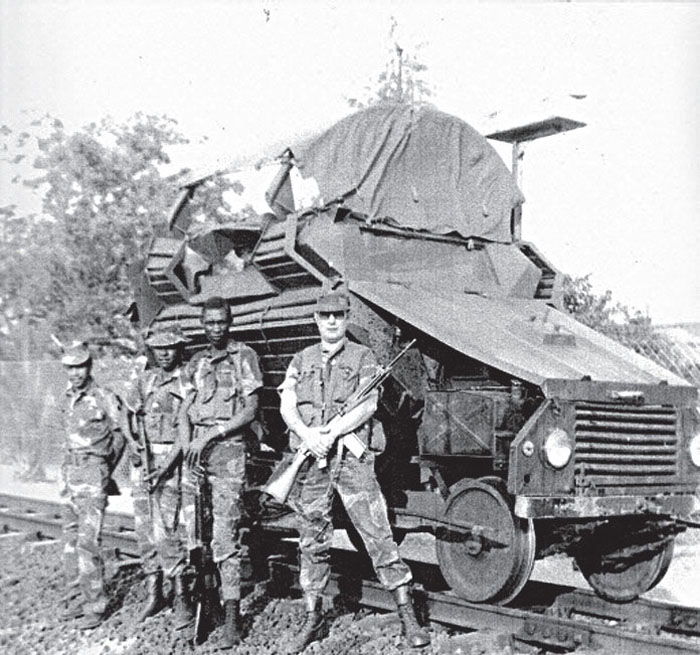
The Kudu, with the armoured body of the O-Jay on the chassis of the Rhino, with the good protection offered by the newer crew compartment, but retaining the Rhino’s shortcomings, especially in regard to its turning capabilities.
(Photo: Boet Du Plessis)
The explosion of the petrol tanks had resulted in some severe burns. The decision was taken to replace their rigid fixtures by sprung metal bands, held in place by 6mm ‘veranda’ rivets in such a way that, in the event of a violent shock, the tank would break free and be propelled some distance from the vehicle.
The question of how to turn the vehicle (since the Land Rover gearbox retained its four forward gears but only one reverse gear) was solved in the classic manner by the provision of a turntable. This was mechanically operated on the initial models and later hydraulically on certain subsequent models.7 On the Rhino, the turntable was carried on the side of the vehicle, which had to be driven up onto it and fastened in place before being turned. On the other models, the device was integral to the chassis, which saved a great deal of time and reduced the risk of accidents from the trolley being badly placed or even falling off.
The next model was the ‘Tusker’, which used the same chassis as the O-Jay, but with a revised crew capsule offering improved protection.8 Some Tuskers were used as transport by signals officers.
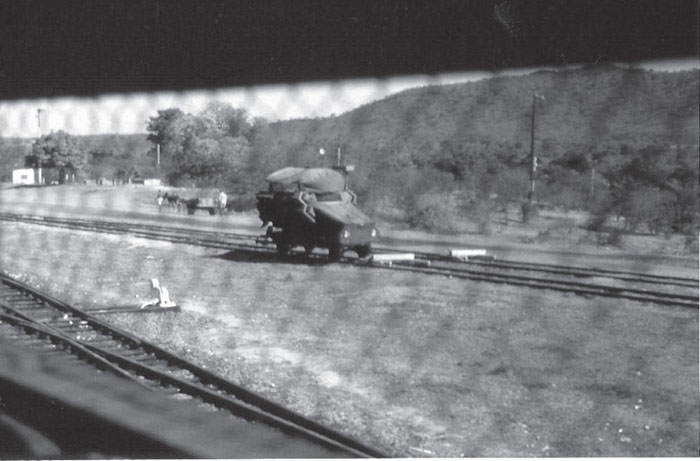
A Kudu parked up, seen from inside a trolley.
(Photo: Horst Schobesberger)
The last type of armoured trolley to be built was the ‘Cougar’, which incorporated all the previous improvements. In particular, it had a double braking system: hydraulic on the rear wheels and vacuum brakes on the front wheels. A radio-controlled trolley was also planned, remotely guided from a second trolley following some 500m behind, but it was not built.
Finally, the ‘Jackal’ was built in great secrecy. It was powered by a Leyland 680 diesel motor. Running 10 minutes in front of the postal train in the direction of Bulawayo, and then intended for use in the Beira Corridor, it did not prove to be a success, mainly because of its excessive weight. It could accommodate thirty-five fully-equipped troops, and was more akin to an armoured personnel carrier than a reconnaissance vehicle.
At midnight on 31 March 1980, all the armoured trolleys were withdrawn from service, with the exception of two Cougars made available to the engineers at Rutenga, and a third Cougar intended for the National Railways Museum, Bulawayo.
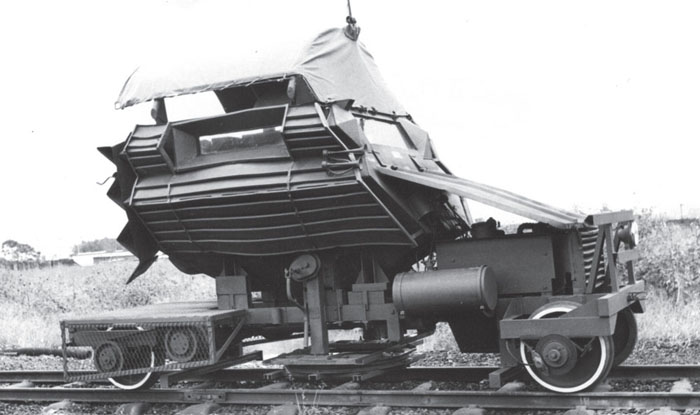
A photo of the O-Jay armoured trolley, showing the disk brakes fitted after it had entered service, and the deliberately flimsy fastening of the petrol tank. For scanning the track the central searchlight was preferred to the fixed front headlamps. The ‘V’ form of the lower armour is clearly visible.
(Photo: National Railways Museum, Bulawayo)
While the trolleys are well known, it should be remembered that the locomotives were also armoured, basically around the cabs and other vulnerable areas. To accompany goods trains, a certain number of platform wagons were fitted with heavy weapons and provided with an armoured shelter at each end and between the gun mountings.9 The wagon crews were drawn from the six specialist Railway Defence Companies of the Guard Force – the fourth element of the Rhodesian defence forces. They operated from Gwelo (Somabula) towards Rutenga and Beitbridge on the South-African border.
The twelve daily goods trains ran loaded in one direction during the night, and returned empty back south during the day. They followed each other at very short intervals to prevent the rebels from profiting from the five or six minutes necessary for planting explosives.10 This was the same procedure as used by the French ‘Rafales’ in Indochina. In addition, the armoured trolleys would run at an interval of about four minutes in front of each train. However, the system was not foolproof, as there were usually more trains than serviceable trolleys. The solution was to run patrols at random, to confine the goods trains to daytime runs, and use the trolleys to patrol during the nights.
Ever since Mozambique had obtained its independence in June 1975, the zone most at risk was the south-eastern section of the railway network carrying the trains vital for Rhodesia’s survival. Therefore the majority of the armoured vehicles were concentrated on the Somabula-Beitbridge line, while the rest were divided between the Bulawayo-Plumtree line to the south and the Bulawayo-Victoria Falls line heading north, except for a few units on the east-bound line to Gwelo and Gatooma. All the armoured units were now linked by radio to the CTC (Centralised Traffic Control). In addition, by passing an electric current through the rails the CTC knew immediately if a section of rail had been cut, or if a trolley had been derailed, and they could despatch reinforcements to the point of attack. For this system to work, the trolleys were fitted with metal brushes on bars just behind the front wheels and just in front of the rear wheels, adjustable so that they would touch the rails and thus close the electric circuit. After independence was declared on 18 April 1980, the attacks by dissident elements led to the re-commissioning of certain units and their despatch in the direction of the Beira railway network.
In conclusion, it is clear that such a technical and tactical evolution of armoured rail units has rarely been achieved elsewhere, and in such a short time span. In the multiple attacks, not one single trolley crewmember was killed. Again, all of the damaged units11 were able to be repaired and returned to service thanks to their robust construction. One must also remember that these developments took place at a time when Rhodesia was suffering under international sanctions aimed at disrupting the supply of spare parts and technology transfer.
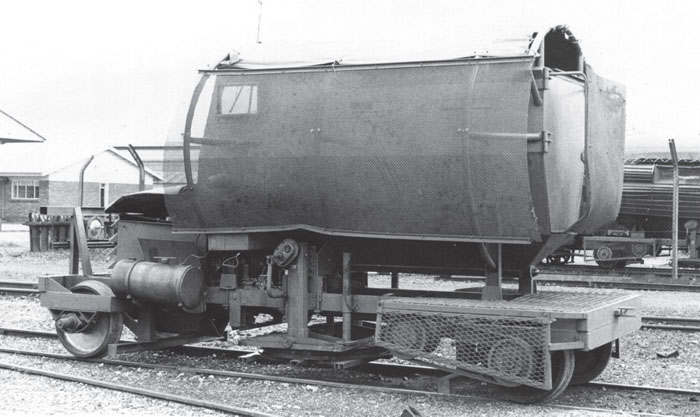
The armoured hull of the Tusker, carried on the standard-type chassis incorporating all the improvements found wanting in the original Rhino, was reputed to offer better protection to the crew, especially with the introduction of the netting to protect against the hollow-charge warhead of the RPG-7 with which the terrorists were well supplied. Of note is the rear door which was the sole means of access on all the armoured trolleys.
(Photo: National Railways Museum, Bulawayo)

A Tusker with a different design of motor compartment protection. These vehicles were painted in the contemporary British Army bronze green finish.
(Photo: Horst Schobesberger)
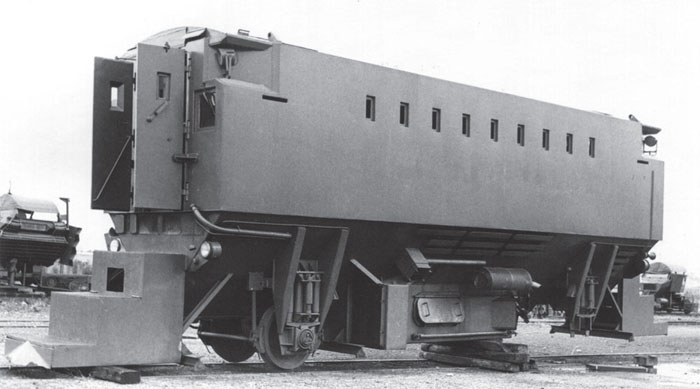
In this view of the Jackal (here with the rear wheels removed) of note are the access stairs which double as cowcatchers. The anti-derailment bars are here clearly visible, with the small plates welded on at each side, intended to keep the unit in a straight line in the case of one wheel being blown off.
(Photo: National Railways Museum, Bulawayo)
This photo of the opposite side of the Jackal on display in Bulawayo shows the different lower section.
(Photo: Glöckner)
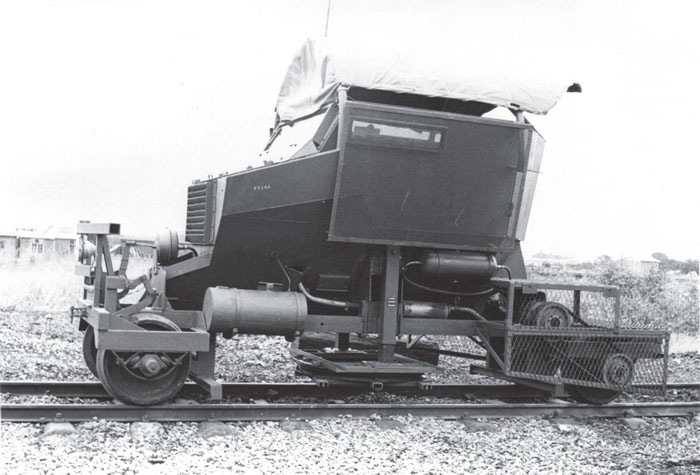
The final type of trolley, the Cougar, incorporating all the modifications resulting from the experiences of the bush war.
(Photo: National Railways Museum, Bulawayo)
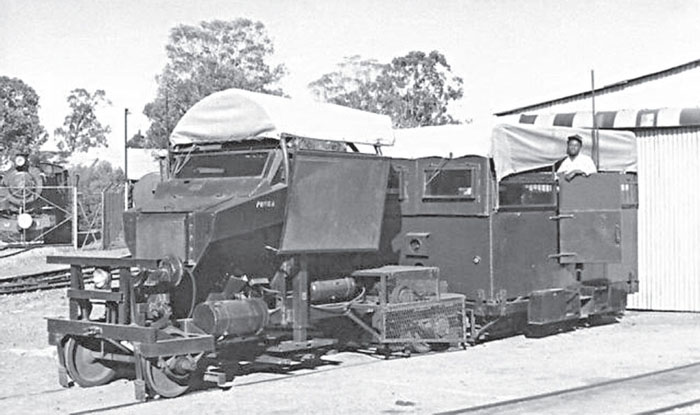
Another photo of a Cougar, parked in front of a fully-armoured Wickham trolley.
(Photo: All Rights Reserved)
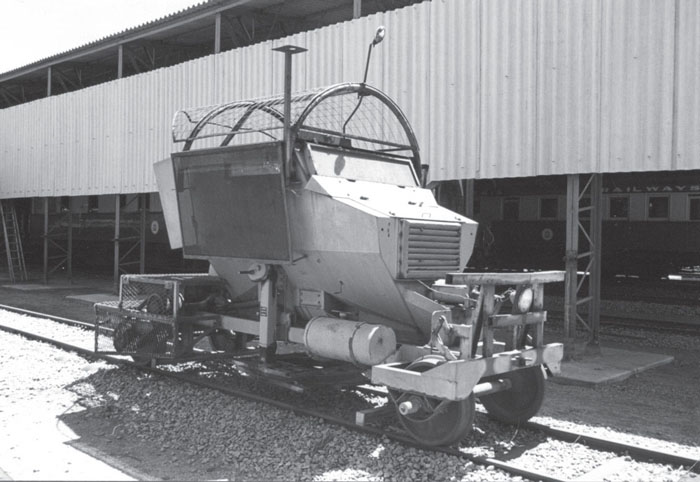
The Cougar preserved in the Bulawayo Museum. Unfortunately, the interior of the vehicle is in poor condition.
(Photo: Olivier Grognet)
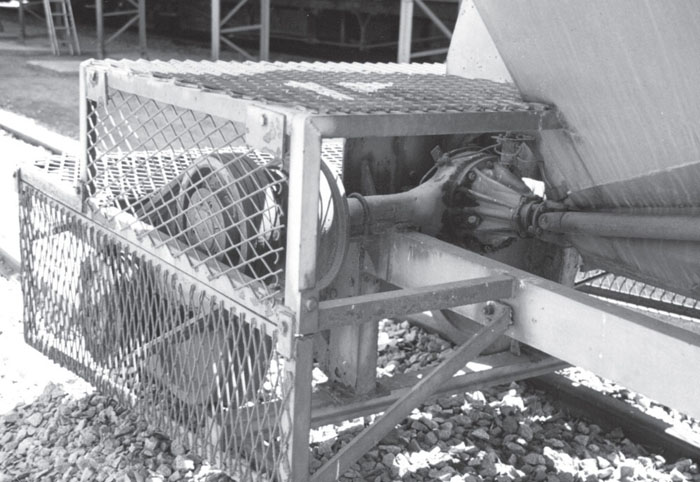
A closeup of the drive train, with a V-pulley which helped reduce the hammer blows caused by the rail joints and also to save the transmission from damage in the event of a derailment. Unfortunately the very first models had a tendancy to shed their belt.
(Photo: Olivier Grognet)
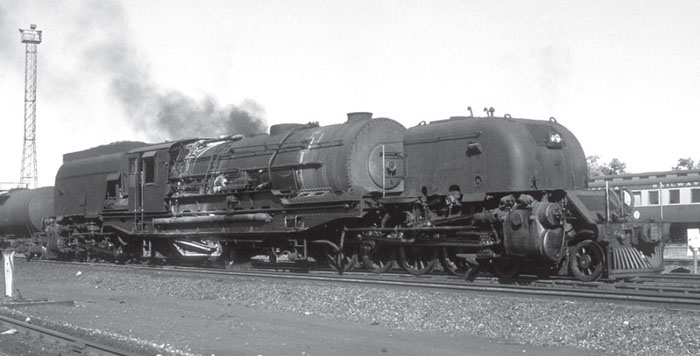
A photo taken in April 1980 showing one of the Garratts hired by the ZRR from South African Railways between August 1979 and September 1981. On these locomotives only the cab was armoured.
(Photo: Peter Bagshawe)
Two DE9A12 armoured locomotives, Nos 1959 and 1957, at Heany Junction in April 1980. The armour plating serving no further use was removed a few months after this photo was taken.
(Photo: Peter Bagshawe)
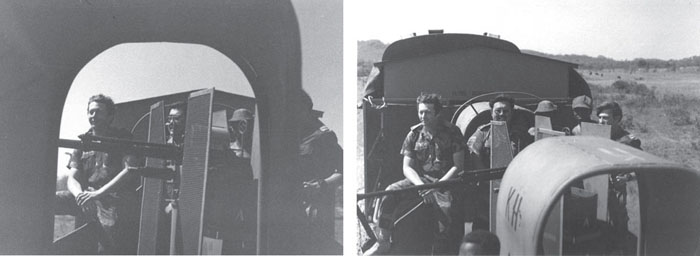
Two shots of the crew of a K Wagon.
(Photos: Horst Schobesberger)
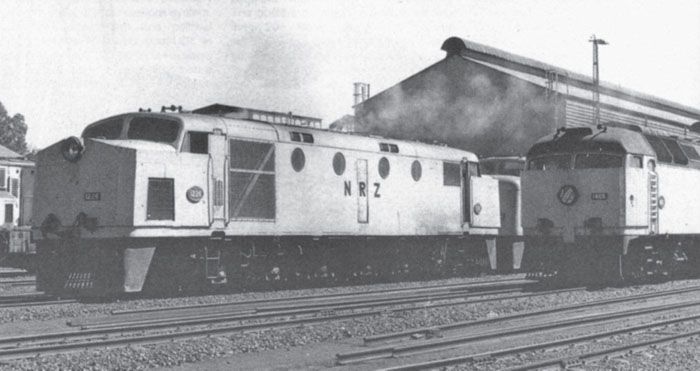
Two diesel locomotives with armour protection (on the left an English Electric Class D.E.2 and on the right a Brush Class D.E.4) used on the Beira Corridor in July 1987.
(Photo: John M. Batwell)
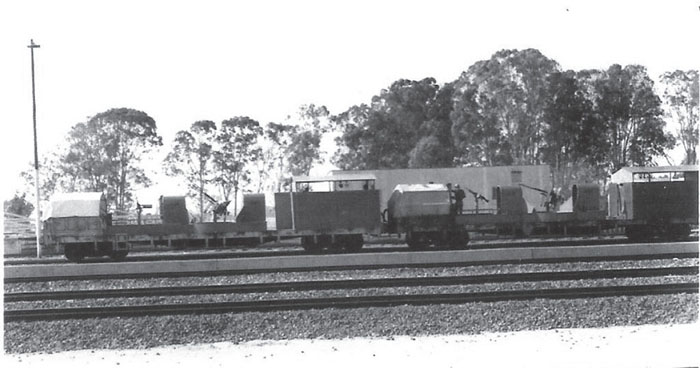
Two K Wagons, each armed with a 20mm cannon and a 7.62mm MAG. One of these wagons is preserved in the Bulawayo Museum.
(Photo: Horst Schobesberger)
SOURCES:
Books:
Bryer, Tom, Terror on the Tracks: a Rhodesian Story (Rothershorpe, Paragon Publishing, 2011).
Hamer, E D, Locomotives of Zimbabwe & Botswana (Malmö: Frank Stenvalls Forlag, 2001).
Website :
http://www.rhodesiansoldier.com/hist-bush-war-railwaysecurity.html
1. Rhodesian railways changed names twice following political changes. From Rhodesian Railways (RR) they became Zimbabwe Rhodesian Railways (ZRR) between 1 June 1979 and 30 April 1980, and then National Railways of Zimbabwe (NRZ).
2. The country itself underwent several changes of name: from Southern Rhodesia (1923–64) to Rhodesia (from 1964), then Rhodesia-Zimbabwe (1979) and finally Zimbabwe (from 18 April 1980).
3. The Zimbabwe African National Liberation Army (ZANLA) was the military arm of the Zimbabwe African National Union (ZANU), and the Zimbabwe People’s Revolutionary Army (ZIPRA) was the military arm of the Zimbabwe African People’s Union (ZAPU).
4. The Rhodesians used the term ‘security trolley’.
5. Long Wheel Base.
6. Mine and Ambush Protected.
7. At one time it had been planned to install turntables at several predetermined points on the railway network, but the project was abandoned because of the excessive costs involved.
8. For example, provision of a motorcycle helmet for the driver, the fitting of safety belts, and the inclusion of first-aid kits, etc.
9. Known as ‘K Wagons’, (‘K’ for ‘Kill’).
10. A line breakage would need on average 24 hours’ work to repair.
11. It is estimated that half of all the trolleys fell victim to an attack, except for the Cougars which entered service only a short time before the end of hostilities.
12. Built in Spain by Babcock & Wilcox.